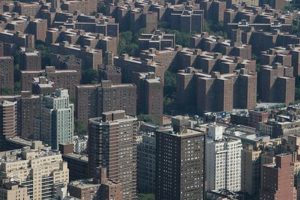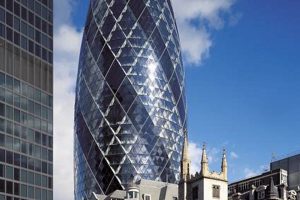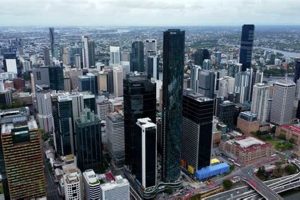Skyscrapers, towering structures that dominate the skylines of major cities, have become iconic symbols of American architectural prowess and economic might. Defined as buildings that rise over 150 meters (492 feet), skyscrapers have revolutionized the way we live, work, and interact with urban environments.
The development of skyscrapers has been driven by a combination of factors, including land scarcity, technological advancements, and the desire for vertical expansion. Early skyscrapers, such as the Home Insurance Building in Chicago (1884) and the Woolworth Building in New York City (1913), pushed the boundaries of engineering and design, showcasing innovative uses of steel frames and elevators.
Skyscrapers offer numerous advantages, including increased land utilization, energy efficiency, and enhanced transportation connectivity. They provide ample space for offices, residential units, and retail establishments, accommodating large populations within a relatively small footprint. Moreover, their vertical design minimizes heat loss and facilitates natural ventilation, reducing energy consumption. Additionally, skyscrapers often incorporate public transportation hubs and pedestrian-friendly amenities, promoting sustainable urban development.
1. Height
The height of American skyscrapers is a defining characteristic that has revolutionized architecture and urban planning. By reaching towards the heavens, these towering structures redefine verticality, creating new possibilities for space utilization and urban development. The pursuit of height has been a driving force behind the evolution of skyscraper design, pushing the boundaries of engineering and construction techniques.
The height of skyscrapers offers several advantages. Firstly, it allows for increased density, accommodating a large number of people and businesses within a relatively small footprint. This is particularly important in densely populated urban areas where land is scarce. Secondly, height can enhance energy efficiency. Taller buildings can take advantage of natural ventilation and daylighting, reducing the need for artificial lighting and HVAC systems. Thirdly, skyscrapers can serve as landmarks and symbols of urban identity, creating a distinct skyline that is recognizable around the world.
The construction of skyscrapers requires innovative engineering solutions to overcome challenges such as wind loads, seismic forces, and material strength. Structural engineers employ advanced techniques and materials, such as reinforced concrete, steel frames, and composite structures, to ensure the stability and safety of these towering giants. The pursuit of height has also led to the development of new construction methods, such as prefabrication and modular construction, which streamline the building process and reduce costs.
In conclusion, the height of American skyscrapers is a defining feature that has shaped the urban landscape and revolutionized architecture. By reaching towards the heavens, these structures redefine verticality, offering solutions for urban density, energy efficiency, and symbolic identity. The pursuit of height has driven engineering innovation and construction advancements, showcasing the ingenuity and ambition of American architecture.
2. Engineering
American skyscrapers are structural marvels that showcase advancements in design and materials, pushing the boundaries of engineering and construction. The pursuit of height and the need to ensure the stability and safety of these towering structures have led to the development of innovative engineering solutions and the use of cutting-edge materials.
- Structural Systems
Skyscrapers employ various structural systems to withstand the forces of gravity, wind, and seismic activity. These systems include reinforced concrete cores, steel frames, and composite structures, each with its own advantages and applications. - Materials Innovation
The construction of skyscrapers requires high-strength and lightweight materials. Engineers have developed advanced materials such as high-performance concrete, ultra-high-strength steel, and composite materials, which allow for lighter and more efficient structures. - Wind Engineering
Skyscrapers are subjected to strong wind loads, which can cause swaying and instability. Engineers employ wind engineering techniques, such as wind tunnel testing and aerodynamic design, to minimize wind-induced forces and ensure structural integrity. - Seismic Design
In earthquake-prone areas, skyscrapers must be designed to withstand seismic forces. Engineers use base isolation systems, energy dissipation devices, and reinforced concrete shear walls to protect buildings from earthquakes.
These engineering advancements have enabled the construction of taller, lighter, and more resilient skyscrapers. They have revolutionized the way we design and build tall structures, pushing the limits of architectural innovation and transforming the skylines of cities around the world.
3. Landmarks
American skyscrapers, with their towering heights and distinctive designs, have become iconic landmarks that shape the identity and character of cities around the world. These architectural marvels transcend their function as mere buildings; they embody cultural significance, historical milestones, and aspirations of the communities they reside in.
- Symbols of Urban Identity
Skyscrapers have become synonymous with the cities they call home. The Empire State Building in New York City, the Willis Tower in Chicago, and the Burj Khalifa in Dubai are instantly recognizable symbols that define their respective skylines. These structures represent the ambition, innovation, and economic prowess of the cities they inhabit. - Cultural Significance
Skyscrapers are often associated with cultural and historical events. The Chrysler Building in New York City, with its Art Deco design, evokes the glamour and optimism of the 1930s. The One World Trade Center, built on the site of the former Twin Towers, serves as a poignant memorial to the victims of the 9/11 attacks. - Tourist Attractions
Many skyscrapers are popular tourist destinations, drawing visitors from around the world. Observation decks, such as the Top of the Rock in New York City and the Skydeck in Chicago, offer breathtaking views of the city and surrounding landscapes. These attractions provide a unique perspective on the urban environment and allow visitors to experience the grandeur of these architectural wonders. - Economic Drivers
Skyscrapers are often catalysts for economic deve
lopment. They attract businesses, create jobs, and stimulate investment in the surrounding area. The presence of iconic skyscrapers can enhance the prestige and desirability of a city, attracting both domestic and international visitors and businesses.
In conclusion, American skyscrapers are more than just tall buildings; they are iconic landmarks that shape city skylines, embody cultural significance, and drive economic growth. They are symbols of urban identity, cultural heritage, and architectural achievement, making them integral to the fabric of the cities they call home.
4. Density
The density of American skyscrapers is a defining characteristic that has significantly impacted urban planning and development. By accommodating vast populations within a relatively small footprint, skyscrapers optimize urban space, offering several key advantages:
- Reduced Urban Sprawl: Skyscrapers reduce the need for urban sprawl by concentrating populations in vertical structures, preserving valuable land for other uses such as parks, green spaces, and infrastructure.
- Increased Land Utilization: High-density skyscrapers allow for more efficient land utilization, maximizing the use of available space in densely populated urban areas.
- Enhanced Accessibility: Skyscrapers often incorporate mixed-use developments, combining residential, commercial, and retail spaces within a single structure. This proximity enhances accessibility to various amenities and services, reducing the need for excessive commuting.
Real-life examples of high-density skyscrapers include:
- Burj Khalifa, Dubai: With a height of 828 meters (2,717 feet), the Burj Khalifa is the tallest building in the world and accommodates a mixed-use development with residential units, offices, and a hotel.
- One World Trade Center, New York City: Standing at 541 meters (1,776 feet), One World Trade Center is the tallest building in the Western Hemisphere and houses offices, retail spaces, and observatories.
- Shanghai Tower, Shanghai: At 632 meters (2,073 feet) tall, the Shanghai Tower is the second tallest building in the world and features a mix of offices, retail, and a hotel.
Understanding the connection between density and American skyscrapers is crucial for sustainable urban planning. By optimizing urban space, skyscrapers contribute to the creation of livable, efficient, and environmentally friendly cities. The vertical growth of cities reduces the need for urban sprawl, preserving natural landscapes and agricultural land. Additionally, high-density developments promote walkability and public transportation, reducing traffic congestion and emissions.
5. Sustainability
The pursuit of sustainability has become an integral aspect of modern architecture, and American skyscrapers are no exception. Embracing green features, these towering structures are designed to minimize their environmental impact and contribute to a more sustainable urban environment.
The incorporation of green features in American skyscrapers is driven by various factors, including environmental concerns, government regulations, and market demand for eco-friendly buildings. Architects and engineers are constantly innovating to develop new and effective ways to reduce the energy consumption, water usage, and carbon footprint of skyscrapers.
Real-life examples of sustainable skyscrapers include:
- Bank of America Tower, New York City:LEED
- The Pearl River Tower, Guangzhou, China:
- Burj Khalifa, Dubai:
The benefits of sustainable skyscrapers extend beyond environmental protection. Green buildings can contribute to improved occupant health and well-being, increased property values, and reduced operating costs. By embracing sustainability, American skyscrapers are not only shaping the skylines of cities but also contributing to a more sustainable future.
6. Mix-Use
American skyscrapers have embraced a mix-use approach, combining residential, commercial, and retail spaces within a single structure. This design strategy plays a pivotal role in creating vibrant urban hubs that offer a diverse range of amenities and foster a sense of community.
The benefits of mixed-use skyscrapers extend beyond convenience and efficiency. They contribute to the creation of more sustainable and livable cities. By integrating different functions within a single building, mixed-use skyscrapers reduce urban sprawl, promote walkability, and encourage the use of public transportation. This interconnectedness fosters a sense of place and enhances the overall quality of life for residents and visitors alike.
Real-life examples of successful mixed-use skyscrapers include:
- Rockefeller Center, New York City: A complex of 19 commercial buildings that includes retail stores, restaurants, offices, and apartments.
- Embarcadero Center, San Francisco: A waterfront complex that combines office space, retail stores, restaurants, and a hotel.
- The Shard, London: A mixed-use skyscraper that houses offices, apartments, a hotel, and restaurants.
Understanding the connection between mixed-use design and American skyscrapers is crucial for architects, urban planners, and policymakers. By incorporating a mix of uses within these towering structures, cities can create more sustainable, vibrant, and livable urban environments.
7. Economic Drivers
American skyscrapers serve as economic powerhouses, catalyzing investment and job creation, which in turn boost local economies. The construction of these towering structures requires significant capital investment, generating employment opportunities for architects, engineers, construction workers, and various other professionals. Moreover, the presence of skyscrapers attracts businesses and investors, leading to increased economic activity in the surrounding area.
Real-life examples illustrate the economic impact of American skyscrapers:
- The construction of the Empire State Building in New York City during the Great Depression provided jobs for thousands of workers and stimulated the local economy.
- The development of Canary Wharf in London transformed an abandoned docklands area into a thriving financial center, creating numerous job opportunities and boosting the city’s economy.
- The Burj Khalifa in Dubai has become a major tourist attraction, drawing visitors from around the world and contributing significantly to the city’s economy.
Understanding the connection between economic drivers and American skyscrapers is crucial for urban planners and policymakers. By investing in the construction and development of skyscrapers, cities can stimulate economic growth, create jobs, and enhance their overall competitiveness. Skyscrapers no
t only shape skylines but also contribute to the economic prosperity of the communities they inhabit.
8. Cultural Significance
American skyscrapers, reaching towards the heavens, are more than just architectural marvels; they are cultural icons that embody the societal aspirations and technological advancements of the United States. These towering structures reflect the nation’s drive for progress, its optimism about the future, and its belief in the power of human ingenuity.
From the early skyscrapers of the late 19th century to the supertall skyscrapers of today, these buildings have pushed the boundaries of design and engineering. They have served as symbols of American economic might and global influence, and have played a significant role in shaping the country’s identity.
The Empire State Building, completed in 1931, was the tallest building in the world for over four decades. It became an instant icon of New York City and has been featured in countless films and television shows. The building’s Art Deco design reflects the optimism and exuberance of the Roaring Twenties, and its towering height symbolizes the city’s status as a global financial and cultural center.
The World Trade Center towers, completed in 1973, were the tallest buildings in the world until their tragic destruction in the 9/11 attacks. The towers were symbols of American ambition and technological prowess, and their destruction was a devastating blow to the nation. The subsequent rebuilding of the World Trade Center site, including the construction of the One World Trade Center, has been a powerful symbol of resilience and hope.
Today, American skyscrapers continue to push the boundaries of design and innovation. The Burj Khalifa in Dubai, completed in 2010, is the tallest building in the world, standing at over 828 meters (2,717 feet). The building’s sleek, modern design reflects the city’s rapid growth and its ambition to become a global player.
American skyscrapers are more than just buildings; they are cultural symbols that reflect the nation’s values and aspirations. They are testaments to the power of human ingenuity and the American dream.
9. Global Influence
American skyscrapers have had a profound global influence, inspiring architectural trends and shaping skylines around the world. The United States has been at the forefront of skyscraper design and construction for over a century, and its skyscrapers have become iconic symbols of American innovation and economic power.
The early skyscrapers of the late 19th and early 20th centuries, such as the Home Insurance Building in Chicago and the Woolworth Building in New York City, were marvels of engineering and design. These buildings pushed the boundaries of what was possible in terms of height and scale, and they quickly became models for skyscrapers around the world.
In the mid-20th century, American skyscrapers began to take on a more modern and international style. The Seagram Building in New York City, designed by Mies van der Rohe, is a prime example of this style. The building’s sleek glass and steel facade and its simple, geometric form have been widely imitated around the world.
In recent years, American skyscrapers have continued to evolve, becoming even taller and more technologically advanced. The Burj Khalifa in Dubai, completed in 2010, is the tallest building in the world, standing at over 828 meters (2,717 feet) tall. The building’s design is a testament to the ingenuity and innovation of American architects and engineers.
The global influence of American skyscrapers is undeniable. These buildings have shaped the skylines of cities around the world and have become symbols of American innovation and economic power. Understanding the connection between American skyscrapers and global influence is important for architects, urban planners, and policymakers around the world.
FAQs on American Skyscrapers
This section addresses commonly asked questions and misconceptions surrounding American skyscrapers, providing informative answers based on factual information.
Question 1: What is the defining characteristic of American skyscrapers?
American skyscrapers are distinguished by their exceptional height, typically exceeding 150 meters (492 feet). This vertical growth defines their presence in urban landscapes and sets them apart from other high-rise buildings.
Question 2: How do skyscrapers contribute to urban development?
Skyscrapers play a significant role in optimizing urban space and accommodating growing populations. Their vertical design allows for increased density while preserving valuable land for other uses such as parks and infrastructure.
Question 3: Are skyscrapers environmentally sustainable?
Modern skyscrapers prioritize sustainability by incorporating green features that minimize their environmental impact. These features include energy-efficient systems, water conservation measures, and the use of recycled materials, contributing to a more sustainable urban environment.
Question 4: How do skyscrapers influence the economies of cities?
Skyscrapers serve as economic drivers by attracting businesses and investments. Their construction generates employment opportunities and stimulates local economies. Additionally, they enhance the prestige and desirability of cities, attracting both domestic and international visitors and businesses.
Question 5: What is the cultural significance of skyscrapers in the United States?
American skyscrapers embody societal aspirations, technological advancements, and the nation’s drive for progress. They have become cultural icons, reflecting the optimism and ambition of the American people.
Question 6: How have American skyscrapers influenced global architecture?
American skyscrapers have had a profound global impact, inspiring architectural trends and shaping skylines worldwide. Their innovative designs and engineering advancements have set the standard for tall buildings, and their influence continues to shape the urban landscapes of cities around the world.
In summary, American skyscrapers are remarkable feats of engineering that have revolutionized urban development, sustainability, and economic growth. Their cultural significance and global influence make them iconic symbols of American innovation and ambition.
Tips on Understanding American Skyscrapers
To enhance your understanding of American skyscrapers, consider these valuable tips:
Tip 1: Explore Historical Context
Delve into the history of skyscraper development in the United States. Trace its evolution from early structures like the Home Insurance Building to modern marvels like the Burj Khalifa.
Tip 2: Understand Structural Engineering
Comprehend the innovative engineering techniques employed in skyscraper construction. Learn about load-bearing systems, wind resistance, and seismic design.
Tip 3: Recognize Architectural Styles
Identify the diverse architectural styles showcased in American skyscrapers. From Art Deco to Modernism, each style reflects the cultural and aesthetic influences of its time.
Tip 4: Appreciate Functional Aspects
Consider the practical functions of skyscrapers beyond their aesthetic appeal. Explore how they optimize urban space, promote sustainability, and serve as economic catalysts.
Tip 5: Analyze Global Impact
Understand the profound influence of American skyscrapers on global architecture. Examine how their designs and technologies have shaped skylines worldwide.
By following these tips, you will gain a deeper appreciation for the architectural significance, engineering prowess, and cultural impact of American skyscrapers.
In conclusion, American skyscrapers are not merely towering structures but testaments to human ingenuity, technological advancements, and the pursuit of vertical frontiers. Through a comprehensive understanding of their history, design, and impact, we can fully appreciate these architectural marvels.
Conclusion
American skyscrapers are architectural marvels that have reshaped urban landscapes, pushed the boundaries of engineering, and become icons of cultural significance. Their towering heights, innovative designs, and sustainable features have transformed cities worldwide, making them symbols of progress and economic might. Understanding the history, engineering, and impact of American skyscrapers is essential for appreciating their architectural brilliance and their profound influence on the built environment.
As we look towards the future, skyscrapers will continue to evolve, integrating technological advancements and sustainable practices. They will play a vital role in addressing urban challenges such as population density, environmental concerns, and economic growth. By embracing innovation and collaboration, we can ensure that American skyscrapers remain beacons of architectural excellence and symbols of human ingenuity for generations to come.







